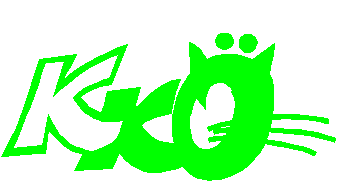The Abyssinian
is a very elegant and active shorthair cat.
Size is medium.
The body together with the legs form more or less a square. The body is
very muscular with senewy slender legs.
The shape of the head is a short modified wedge where all lines and curves are soft and
gentle.
What does that mean ?
Looking on the head either from the front or in profile
there should not be seen any straight lines or flat planes. The forehead is gently curved,
the muzzle is gently curved and round, i.e. the head is not pointed.
When viewed from the side the head is rather short, the nose shows a gentle curve and
the profile is
not straight.
Ears are fairly large and wide at the base, when viewed from the side they are slightly
tilted forward, called pricked, which gives the cat this certain alert expression.
Eyes are large and almond in shape and very brilliant, you get caught by these eyes.
The tail is medium to almost long with a rounded tip, i.e. not pointed like on the
Siamese. |
Abyssinians exist in the following colours:
|
The most characteristique and
important part of the Abyssinian is its coat, in the non-silver colours it shows a rich
base colour and each hair of the upper body parts is ticked, which means each hair shows
several bands of the base colour alternating with the darker colour of the ticking, the
tips of the hairs are coloured with the same darker colour as the ticking.
The ticking is it what gives that certain impression of wild hairs as you can see it also
f.e. on rabbits and deers.
The underside of the body (chest, stomache, innerside of the legs) is without ticking. |
 |
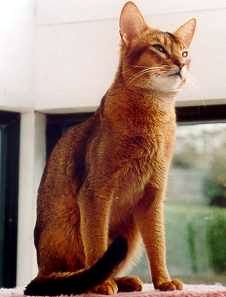
Klivius Rosa Glauca, Abyssinian
ruddy
Ingeborg Kemetner
In the ruddy Abyssinian the base
colour is a rich orange colour, the hairs are ticked with dark seal.
The ruddy Abyssinian is genetically black, the warm coppery coat colour comes from
rufismus (caused by rufus polygenes) which has been increased over the years through
sorrowful selective breeding.
|
In the face you can see,
that the Abyssinian is a tabby cat (called Ticked Tabby), because you can find the typical
tabby markings like the "M" on the forehead and the rims around the eyes. But on
all the other parts, like around the neck, the flancs, the legs and the tail no stripes or
rings are permitted.
The best place to see which colour the ticking has is the tail tip which is uniform in
colour.Hairs are quite fine and thin.
The Abyssinian has short hairs which are close lying to the body.
See also the Somali
which is the longhair counterpart of the Abyssinian. |
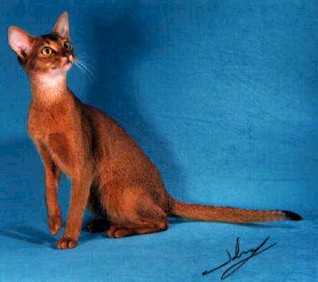
Baton Rouge
Christine Rüssheim
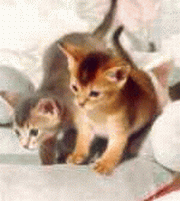
Abyssinian babies
Ingeborg Kemetner
In the sorrel Abyssinian the base
colour is apricot, the hairs are ticked with chocolate.
In some federations this colour is called "red", which has nothing to do
genetically with the red colour caused by gene "Orange", but with gene "bl"
an allel of "b", called cinnamon. |
|
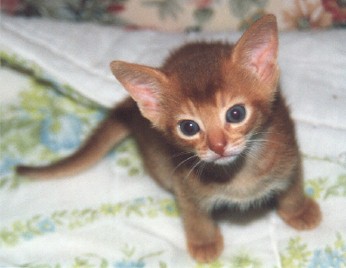
Devaraja Tudor Rose, Abyssinian
sorrel
Diana Keeling |
|
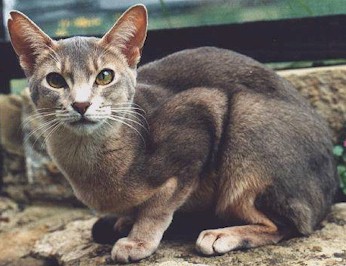
Ch. Mikkar Heathermist, Abyssinian
blue
Mike & Karen Shammas
In the blue Abyssinian the base
colour is blue-grey with a beige ground colour, the hairs are ticked with dark blue.
Chest, stomache, innerside of the legs are coloured with the beige ground colour and don't
show any ticking.
|
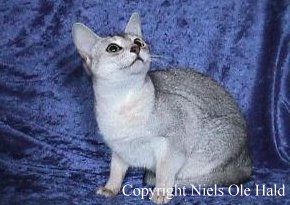
Maichrest Philine, Abyssinian black silver
Leila Nielsen
In the black silver Abyssinian the
base colour is silver white, the hairs are ticked with black.
It is very difficult in this colour not to
have a yellow tinge in the coat (mainly not in the face, on the back and the front legs)
which is caused by too much rufismus.
Chest, stomache, innerside of the legs are silver white without any ticking or darker
colour patches. |
History
The Abyssinian is one of the oldest breeds and very popular. The
coat pattern is based on one single gene, called Ta (ticked tabby),
which does not occur with such a strict expression in other breeds.
The origin is likely to be traced back to those cats which had been painted
and sculpted in Ancient Egypt. It is said that in the 1860s a cat named Zula
was imported to England
from Abyssinia (Ethiopia). The names for this breed had been several ones, like
Abyssinian, Hare cat or Bunny cat because its ticked coat is very similar to the wild hair
of the rabbits, in France the ruddy colour is still called lièvre. The colour was
described in 1889 as "deep brown ticked with black, somewhat resembling the back of a
wild (only not so grey) rabbit". Also other colours have occured in this breed quite
early, like the so-called red which was already mentioned in 1887.
Already 1917 the first Abyssinians were registered with CFA. In 1929 the Abyssinian was
recognized in France. |
Temperament
The Abyssinian is extremely gentle and affectionated to people. They are
very good companions, not excessively "talkative". They are interested in
their surroundings, which gives them this very special expression in their
sparkling brilliant eyes. Nothing is too small, nothing too big not to be
subject of their adventure of investigation.
They love to climb, but very seldom break or distrub things, even when they
move between things like a slalom skier.
This breed seems to be able to read and anticipate the needs of their
favorite persons. |
Grooming
The Abyssinian has very short and rather fine hairs, and the coat is
close lying. Their coat has no tendency to get filthy or knotted. They do
not need to be bathed or excessively combed and brushed. Grooming is rather
easy, from time to time one should lightly brush them so that the old and dead hairs
get out from the coat. |
